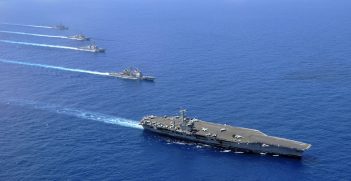Chinese Strategic Control of the South China Sea – Maritime Trade Implications for Australia

For the second time in living memory, the West has lost strategic control of the South China Sea (SCS). The first time was 1940-41, when Imperial Japan obtained strategic dominance of the SCS by occupying French Indochina.
The People’s Republic of China (PRC) is a totalitarian communist imperium which, like Imperial Japan, is territorially aggressive and economically predatory. The PRC is currently consolidating and normalising control of the SCS seized in 2015 following 20 years of hybrid warfare. Their normalisation phase will include civilian settlement of the artificial military base-islands, establishment of a “patriotic tourist industry” and cynical insistence that the artificial military base-islands it forcibly seized are sovereign territory and therefore possess territorial seas and exclusive economic zones (EEZ).
In 2016, the Hague Arbitration Court condemned PRC belligerence and under the UN Convention on the Law of the Sea ruled that China had stolen Philippines territory. Beijing ignored this, treating the “international rules-based order” with contempt, insisting that there be international legalisation treating their artificial military bases as if they were natural islands. None of this is new, mirroring Imperial Japanese actions of 1931-41. During the 1920s and 1930s, the British Empire met Japanese hegemonic intent with the Singapore Strategy, an international defence burden-sharing arrangement to build a global oil refuelling system. It included a base at Singapore to allow the Royal Navy to contest Japanese control of the SCS to protect vital British maritime trade in the Indian Ocean.
PRC seizure of the SCS represents the application of continental military philosophy to the sea: a trade route is being garrisoned via fortress-building. This is not the action of a seapower state in the Corbettian sense, but it does provide PRC dominance of the SCS over small regional powers. As in the 1920s, the obvious response is coordinated international defence burden-sharing. While the danger has been recognised 15 years too late, initiatives such as the Indo-Pacific Maritime Coordination Cell may help prevent losing strategic control of the Indian Ocean. The PRC requires this to contain India and protect its vital Persian Gulf oil trade, now about 43 percent of their oil imports. For the first time in history, China is now dependent on maritime trade, partially explaining their hegemonic aspirations in the region. This also helps explain PRC territorial aggression in the SCS and efforts to dominate the Indian Ocean as part of its Belt and Road Initiative.
This issue is not new and has historical precedent; there is no excuse to pretend that “the rules-based international order” will be any more effective in 2019 than it was in 1931-37, when Japan went from crisis and seizure of territory to a general regional war. The Chinese Communist Party (CCP) is acting on national sovereign requirements which ignore the “rules-based international order.”
International maritime trade will move into those zones the PRC dominates under their sufferance, or under escort. If the Australian Strategic Policy Institute (ASPI) is correct and there is a strong possibility of major regional conflict within or originating with the PRC, then the SCS would become a war risk zone. This would drive normal shipping away and east of the Philippines, while severely restricting or stopping PRC trade. This would hinder globalisation, drive up freight rates and cause serious shortages of global maritime trade system carrying capacity. It would also force regional governments (including Australia) to implement war risk insurance schemes, Naval Coordination and Guidance of Shipping (NCAGS).
None of this is new. It happened with the outbreak of the two World Wars. The ASPI assessment is that we have left the 1958-2000 era of limited wars and returned to an era where major regional or general conflict is once again possible. In turn, this mandates a revival of national war mobilisation planning, as the impact of a major regional or general conflict on Australia would be as profound as it was in the twentieth century. For example, 87.6 percent of the Pilbara iron ore trade from Port Hedland and Dampier is exported to China. Dampier exported 249 ships with 16,586,035 tons of LNG to Japan and South Korea via Lombok and the Philippines and 57 ships with 4,073,506 tons to China via the SCS. In 2015, coal exports from the east coast consisted of 962 ships with 82,330,812 tons of coal to Japan, 450 ships with 45,878,824 tons to South Korea and 759 ships with 70,959,778 tons to China.
These trades form the iron ore, LNG, steaming and coking coal backbones of these national economies, giving Australia leverage in sea supply as they are critical imports for these East Asian countries. Yet these figures also indicate shortages in carrying capacity should the PRC merchant tonnage be removed from the global trade system.
In conclusion, the loss of strategic control of the SCS has destabilised the region and revealed the PRC to be intent on regional hegemony. This mirrors the strategic situation of the 1930s, which generated a major regional war by 1937 and expanded to general war in 1941. This level of strategic risk is without precedent since the late 1950s and requires responses dormant in Australia since that era.
Dr Mark Bailey completed his doctorate at the Australian Defence Force Academy in 2019. The thesis is entitled ‘The Strategic and Trade Protection Implications of Anglo-Australian Maritime Trade 1885-1942’. He joined the Royal Australian Naval College in 1979 as a Seaman officer, serving aboard a variety of vessels including the aircraft carrier HMAS Melbourne and frigate HMAS Yarra.
This is the first article in a series of articles on the South China Sea published on Australian Outlook, first prepared for a workshop on the South China Sea, hosted by the Maritime Security Research Group at UNSW Canberra.
This article is published under a Creative Commons Licence and may be republished with attribution.





